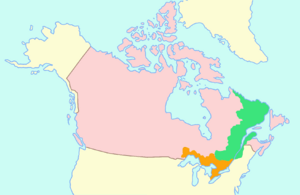Rebellions of 1837–1838 facts for kids
Quick facts for kids Rebellions of 1837–1838 |
|||||||
|---|---|---|---|---|---|---|---|
| Part of Atlantic Revolutions | |||||||
 The Battle of Saint-Eustache, Lower Canada |
|||||||
|
|||||||
| Belligerents | |||||||
Château Clique |
|||||||
Family Compact |
Hunters' Lodges |
||||||
| Commanders and leaders | |||||||
| John Colborne, 1st Baron Seaton Francis Bond Head James FitzGibbon George Gurnett Henry Dundas Allan MacNab Charles Stephen Gore George Augustus Wetherall |
Louis Joseph Papineau William Lyon Mackenzie Thomas Storrow Brown Jean-Olivier Chénier Robert Nelson Wolfred Nelson Ferdinand-Alphonse Oklowski Anthony Van Egmond Cyrille-Hector-Octave Côté Charles Duncombe Nils von Schoultz |
||||||
The Rebellions of 1837–1838 were two armed uprisings in Lower Canada and Upper Canada. These events happened in 1837 and 1838. People were frustrated because they wanted more political power. They especially wanted a "responsible government." This means that the government leaders would be accountable to the people's elected representatives.
These rebellions led to big changes. One change was the Act of Union 1840. This law joined Upper and Lower Canada into one province. Eventually, these events helped create the country of Canada as we know it today.
Contents
Why the Rebellions Happened
The rebellions in Canada were part of a bigger trend. Many parts of the world were seeing people fight for more freedom. These events are sometimes called the Atlantic Revolutions. They included the American Revolutionary War and the French Revolution. People wanted more say in how they were governed.
In Canada, many people wanted a government where citizens could elect their leaders. They wanted the legislative council to be elected, not chosen by the King. The British military stopped these rebellions. This ended the idea of Canada becoming a republic at that time.
The Rebellions Begin
There were two main rebellions, one in Upper Canada and one in Lower Canada. After the first fights, many rebels, like William Lyon Mackenzie, went to the United States. Mackenzie even started a short-lived "Republic of Canada" on Navy Island.
Other rebels, like Robert Nelson, helped create a group called the Hunters' Lodges. This group was mostly made up of Americans. They wanted to declare another Republic of Lower Canada. This led to more fighting, known as the "Patriot War." The American government helped stop these raids. The fighting finally ended about a year after it started.
What Was Similar?
Both Upper and Lower Canada had similar problems. Their governments were supposed to balance power between the King, nobles, and the people. But in Canada, the "noble" part was missing. Instead, powerful local groups controlled things.
In Lower Canada, this group was called the Château Clique. In Upper Canada, it was the Family Compact. These groups held all the important jobs. They were not elected by the people. Many people felt these governments were unfair.
Also, the economy was struggling. Farmers had bad harvests in 1836–37. They were in debt and faced lawsuits. This made many people very poor.
People who wanted change formed "political unions." These groups organized protests. In Lower Canada, they were called the Société des Fils de la Liberté (Sons of Liberty). In Upper Canada, William Lyon Mackenzie helped start the Toronto Political Union. These groups eventually led the rebellions.
What Was Different?
The rebellion in Lower Canada was often seen as a fight between British and French people. French Canadians felt they were not treated fairly. This led to many people supporting the rebellion there.
The Lower Canada rebellion involved many actions like boycotts and strikes. The government responded harshly. They limited people's rights and even burned villages. Many people were arrested or sent away.
The Upper Canada Rebellion was different. It did not have as much support from everyone. It was stopped quickly by smaller groups of loyal volunteers. It was not as widespread or violent as the one in Lower Canada.
What Happened After

After the rebellions, many rebels were arrested. Some were found guilty of going against the King. About 100 Canadian rebels were sent to prison colonies in Australia for life. Some, like Samuel Lount, were publicly executed.
The main reason for the anger in Upper Canada was not against Britain. It was against the unfair actions of local politicians, the "Family Compact." The government said that people who wanted a republic could leave. Those who fought were guilty of treason.

After the fighting, more moderate leaders became important. The British government sent Lord Durham to find out why the rebellions happened. He suggested two big changes:
- Responsible Government: This was one of the rebels' main goals. It meant the government would answer to the elected representatives. It finally happened in 1849.
- Uniting Canada: Lord Durham also suggested joining Upper and Lower Canada into one province. This became the Province of Canada in 1840. This new province was the start of modern Canada.
Lord Durham also suggested that French Canadians should adopt English language and culture. This was a controversial idea. The joining of the two Canadas was partly meant to reduce the self-government of French Canadians.
The rebellions also changed how Britain and the United States got along. Both countries wanted peace. They worked together to stop further raids and problems. These events helped shape the relationship between Canada and the US.
Legacy of the Rebellions
In 1937, 100 years after the rebellions, a group of Canadian volunteers fought in the Spanish Civil War. They were called the Mackenzie–Papineau Battalion, or the Mac-Paps. They were named after William Lyon Mackenzie and Louis-Joseph Papineau, two leaders of the 1837 rebellions. Their rallying cry was "The Spirit of 1837 Lives on!"
See also

